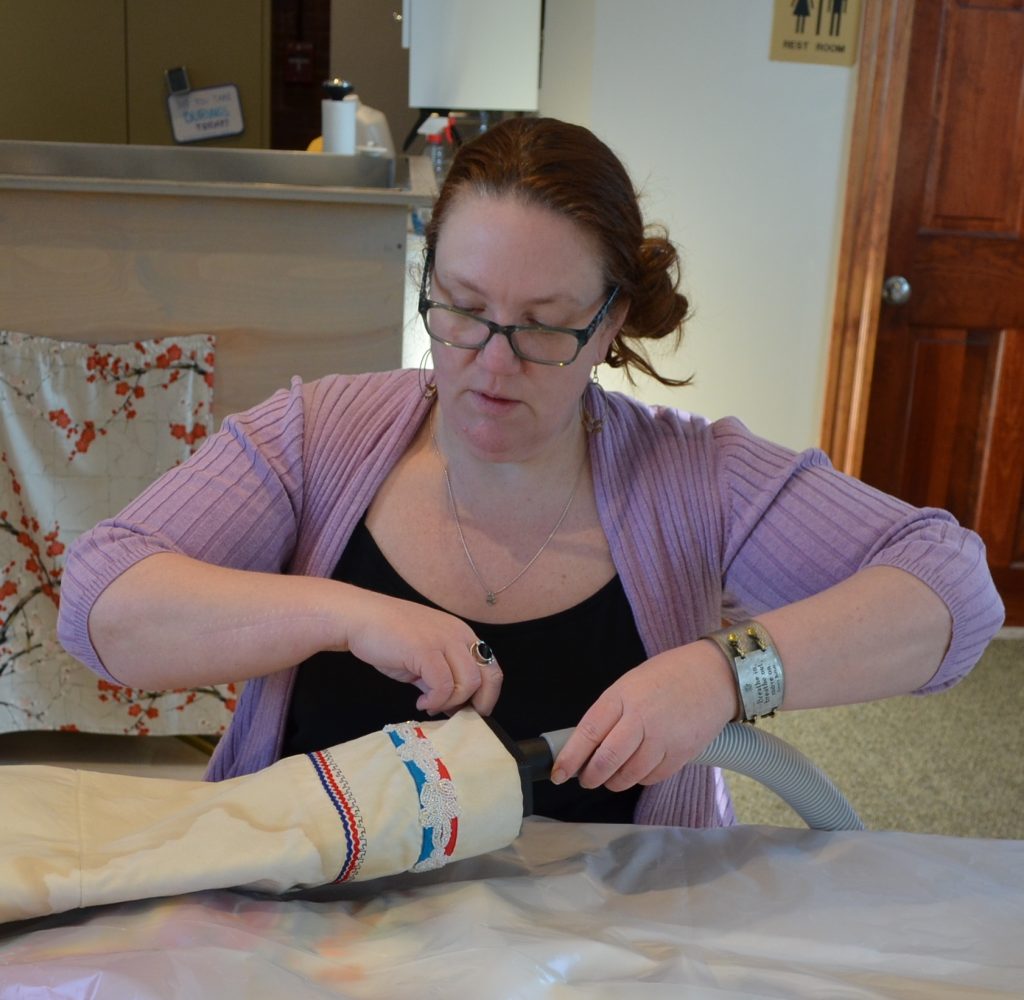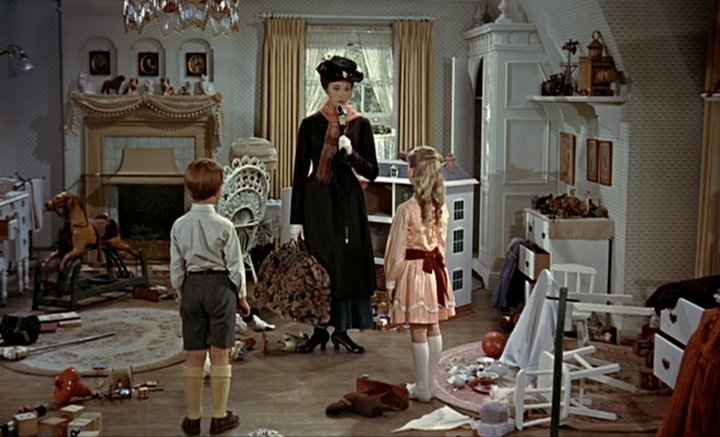
If the mere thought of clothes moths fluttering out of your closet strikes terror into your heart, imagine if your wardrobe didn’t just contain your favorite tweeds and winter cardigans, but also historical artifacts from centuries ago. Those are kinds of things that Camille Myers Breeze and her team work on at Museum Textile Services, a full-service textile preservation studio based in Andover, Massachusetts. In the art world, conservators specialize by medium — some focus on architecture, others on oil paintings, and others still on paper. Breeze specializes in all things made from fabrics and fibers. Over her thirty-year career, she’s helped to conserve 14th-century tapestries, historical battle flags, pre-Columbian textiles, tiny embroidered baptismal caps once worn by US Presidents, and even ancient Peruvian mummy bundles. She’s published extensively on the topic and today teaches classes on textile conservation.
So, when I thought about writing something on clothes moths last month — inspired by this scary photo of someone leaving their wardrobe to freeze in a Chicago garage — I decided to talk to someone who deals with the truly irreplaceable. Breeze doesn’t just treat moth problems, of course, but her work sometimes involves treating an infestation when she’s working with a museum or historical center.
There are two types of insects that eat protein-based fibers (e.g. wool). The first is the carpet beetle, which is a tiny, round bug, sometimes striped, that’s attracted to the warmth of windows. In the Northeast, carpet beetles are so common, many consider them to be part of architectural structures. Second, you have clothes moths, which come in two varieties: there’s the casemaking clothes moth and then the more common webbing clothes moth. “With climate change, we’re seeing a huge surge in the number of infestations in homes, museums, and historic places,” says Breeze. “It’s a global problem, but especially so in Europe and the United States. Conditions today are more favorable for these insects, which means we’re seeing infestations in historical collections and cultural heritage locations where there traditionally haven’t been any problems.”
The worst news? April is National Hatching Month for clothes moths in the United States, which means there’s a good chance you’ll deal with this problem soon enough. Here are some suggestions from a museum textile conservator on how to make sure your favorite winter knits and coats will see their way to the end of this year.

Prevention is the Best Cure
As you may have guessed, the best measures are preventative, and they include the sort of sensible housekeeping that no one likes to do. When I asked Breeze how often people should be vacuuming their closets, she laughs. “How often do you vacuum the back of your closet?,” she asks me. I lie and tell her “rarely,” even though the answer is closer to never. (Ok, fine, the answer is actually never. You happy?). “Exactly. But these pests like places that are dark and lifeless, so at the very least, it helps to frequent your closet often and have a light source inside there.” If you can vacuum every once in a while — say, for spring cleaning — all the better. “It’s an ecosystem,” she says. “While cobwebs keep certain pests at bay, they can be a food source for others. Vacuuming removes those cobwebs and anything you may have tracked in from the outside, all of which will make the environment less likely to be infested.”
When the weather starts to warm up, it helps to store your off-season clothes in another location with the items locked inside bins or zipped into garment bags. First, however, you’ll want to wash or dry clean all your items before storing them away, as dirt makes your clothes more attractive to pests. For knitwear, Breeze recommends using rigid Tupperware bins, which are made from a stable, food-grade, hard plastic known as polypropylene. “They’re as good as museum boxes,” she says. “Before I store mine away, I slip a cotton sheet or pillowcase over the top, then snap the lid down. The bugs you’re trying to keep away from sweaters are those that eat protein. They’re very different from those that eat cellulose. Things such as silverfish will eat cotton, linen, and other cellulose fibers, but anything that eats wool will have to get through that cotton sheet first. It just adds one more layer of protection.”
Garment bags can also be effective solutions for suits, sport coats, and outerwear, but you’ll want to buy the right kind. Cheap ones with plastic or plasticizers can off-gas chemicals as those plastics age, embrittle, and stiffen. And those chemicals, in turn, can accelerate the aging of your fabrics or even stain them. “Vintage fabrics can be especially delicate since they’re already partially aged,” notes Breeze. Instead of storing clothes in the cheap and thin garment bags you may have picked up from a local dry cleaner, Breeze recommends springing for something made from cotton or even polyester, which are inert. (I buy mine from The Container Store for about $20 a piece. They don’t have the see-through plastic window that can help you identify your item from the outside, but you can get around this by just looping a hang tag off the zipper pull).
These bins and bags can also be a smart way to introduce a newly purchased item in your home. Brand new items bought from a trusted source will always be fine, but vintage and second-hand items can often use some monitoring before you stuff them away in your closet. Breeze recommends putting those items in a bin or bag for a while, and just seeing if any issues arise. Or, even better, wash or dry clean them before introducing them into your wardrobe.
Breeze stresses against using any kind of chemical for your maintenance plan. Things such as mothballs aren’t just bad for pets, but they’re also carcinogenic for people. “If you can smell something in the room, that means some kind of chemical is present. Remember that fabrics are very sensitive and will pick up things from their environment. For a maintenance plan, I would steer people away from using any kind of chemical for a solution, especially if you have pets.”

What If You Spot A Clothes Moth?
One of the problems with clothes moths is that you often don’t know there’s an infestation until its too late. The critters responsible for leaving Swiss cheese holes in your clothes aren’t actually the flying beasts themselves — it’s the larva, the stage of moth life before they hatch their wings. Once these tiny worms come out of their eggs, they look for a source of protein (e.g. wool) to eat before they pupate. Sometimes you’ll find the little rice-shaped cocoons they leave behind, but more often than not, you’ll spot the adult clothes moths fluttering around as they look for a mate to reproduce.
So, what to do then?
“The first thing is to clean and separate your clothes,” says Breeze. “Isolate the things you can machine-wash, such as your shirts, and machine-wash them. Then put these items in their own storage space temporarily. Next, dry clean whatever should be dry cleaned. Good dry-cleaning is expensive, but this is a preventative measure. Your clothes may have larva and eggs you can’t see. Cleaning these items is a sure-fire way to ensure that the items are safe to reintroduce in your home.”
Cleaning every item in your closet can be impractical, however, especially if you have a large wardrobe. So, for things you’re unsure of, Breeze recommends bagging those items up and putting them into the trunk of your car. “Especially in the winter or summer months, if you put a couple of sweaters in black bags and drive them around in your trunk for a few weeks, any extreme in temperature is going to reduce the chances you’ll have an infestation on the object,” she explains. “Museums have a few ways to deal with infestations. The first is to use certain chemicals; the second is to take the oxygen out of an environment using an anoxic chamber. Neither of those is realistic for homes, so you can re-create the third solution, which is to play with extremes in temperature, both hot and cold.”
Once you’ve dealt with the garments, you’ll want to clean your space thoroughly. Vacuum your closet, wipe down shelves, and spray the area with Cedarcide. “Cedar oil dries out their carapace. It affects every stage of their lifecycle, from larvae to adult,” she says. “You don’t want to spray this on your clothes because it may stain certain fabrics, but it’s fine for your walls and floor. It’ll sink in and have residual benefits. Plus, it’s much better than using diatomaceous earth, which is a very fine powder you often see recommended for these infestations. Some people recommend that because it scratches the bugs and kills them, but it’s not safe for pets or people to breathe in. I wouldn’t put that into floorboards.”
“What About These Products?”
The market is full of moth production products, ranging from affordable $10 blocks of aromatic cedar wood to considerably more expensive $350 “ZappBug ovens.” But are they worth it? We asked a museum textile conservator for her opinion.
Moth Traps: “These traps lure moths in using pheromones, but you won’t catch enough of the adults to eliminate a problem. Essentially, they’re a good way to know if you have an infestation. Living in the Northeast, I know carpet beetles are so common, I don’t flip out when I see one. I just keep in mind that maybe I shouldn’t leave my sweaters at the back of my closet. Moths are a different thing. Unless your windows don’t have any screens, or if you have a hatch at the top of your closet that goes into your attic, you really shouldn’t see any of them. If you leave the traps out and see a moth, you have a problem. Just make sure it’s a clothes moth. You can read more about it on the internet, but not all moths are clothes moths.”
Mothballs: “Terrible, absolutely don’t recommend using them. Mothballs have naphthalene, which isn’t just terrible for pets, but also people. They’re carcinogenic. When you smell mothballs, you are inhaling the insecticide.”
Cedar Blocks: “Cedar blocks provides a slow release of cedar oil. It can turn an otherwise attractive closet into a place where insects are less likely to go, but they’re not going to solve a problem that’s already there. Say you inherit your father’s collection of coats and you put those garments in a guest closet. If you notice a moth problem in the guest closet, it’s not a bad idea to put cedar blocks in your own closet and maintain strict housekeeping in that room. That’ll deter moths from traveling from one room to the next, but putting cedar blocks in the guest closet alone won’t get rid of those moths that are already there.
The other thing is to not put them next to your garments. They have oils and I can see how certain fabrics can slowly stain over time. So put these around your closet, but not directly in contact with clothes. Cedar blocks also have a certain shelf life, so follow the manufacturer’s recommendations. I would err on the side of caution when it comes to replacement. And avoid those with a strong smell. Some of the ones they sell in hardware stores smell absolutely foul. Any time you have a large aromatic presence, that means you have chemicals around, which can negatively impact your clothes.”
Lavender Sachets: “These and other herbs can be excellent. Like with cedar blocks, you don’t want to put these right up against your garments because their oils can stain. But they can be a good way to deter pests from coming into your closet.”
ZappBug Heater: “I’ve never seen this product before, but it looks like it’s based on the same principle we use to treat infestations, which is to play with extremes in temperatures. I would only warn that, since garments are sometimes made with interlinings and glue, you want to be careful with these solutions. Vintage garments can also be a little more delicate and brittle. Depending on how these solutions work, you could harm your garment. I would just follow the manufacturer’s recommendations.” [Note, the Hanger Project, a former sponsor on this site, has a YouTube video demonstrating their ZappBug Heater kit].
Many thanks to Camille for taking the time to speak with us! Readers who have a 14th-century medieval tapestry, tiny Presidential baptismal cap, or ancient Peruvian mummy they want to preserve can contact Museum Textile Services.








